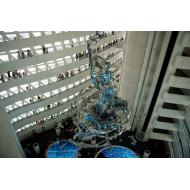LED modules performance depends on the correct choice of control gear, considering the parameters defined for the module. And these are precisely the parameters that we will analyze in the current article.
An LED module’s electrical, photometric, luminous and heat performance is determined by:
- Choice of LED. At present, the market offers numerous LED solutions for different applications and with completely different characteristics
- The electrical circuit
- System heat management
Selecting an LED – Binning
During the LED semiconductor manufacturing process different results arise in its basic parameters. This explains why manufacturers classify them by bins, as a way to name the different types or categories obtained within the same type of LED. The testing and classification process of LEDs into each one of these categories is called binning.
Bin classification or types:
- Direct Voltage bin
- Colour bin
- Luminous Flux or Brightness bin
This means that the design of the light source or luminaire will have more or less performances depending on the choice of bin.
The use of a single bin in each category ensures perfect uniformity.
MacAdam ellipses – SDCM
We can find different colour tones or uniformities within the same colour temperature, consequently this fails to provide us with enough information. These are the so-called MacAdam ellipses that characterise colour uniformity.
These ellipses are represented in the chromaticity diagram and we can come across different sizes, as can be seen from the following figure:
The measurement scale for these ellipses is determined by the standard deviation of the colour matching (SDCM – Standard Deviation of Color Matching).
Module colour uniformity is measured by tracing different ellipses around the quadrant of the chosen colour temperature. The SCDM number is determined by the ellipse that contains all the colour bin values used in the module.
Therefore, the smaller the ellipse the less colour deviation obtained. Generally speaking, it can be said that the human eye responds to the following classification:
- 1 SDCM: There are no colour differences
- 2-4 SDCM: There is hardly any visible difference
- 5 or more SDCM: Colour is easily perceived
Electrical circuit
When it comes to designing an LED module, the baseline requirements must first be established. These are normally electrical in nature: voltage and current and photometric features: Lumens. The outcome and resulting quality will be determined both by LED distribution within the module, as well as by their electrical connection.
In Constant Current-powered LED modules, the internal electrical connection is based on interlinking LEDs serially forming a branch. The connecting of several branches in parallel goes to make up the LED module.
The number of LEDs connected in series that are connect- ed by each branch determines the module’s output voltage, given that this is the sum of the direct voltages at each one of LEDs (VTOTAL = VLED_1 + VLED_2 + … + VLED_N).
Therefore, the output voltage will depend on the voltage bin chosen. Important dispersions as a result of not choosing the voltage bin properly can make the independent LEDs work in an unbalanced manner causing disparate heating and thus shortening their useful life.
The current circulating through each LED is equal to the input current (IIN) divided by the number of branches (ILED = IIN / No. branches).
The module manufacturer defines the input current (IIN) in accordance with the number of branches, based on the fact that each LED type has a typical operating current, deter- mined by the LED manufacturer in order to ensure:
- Service life prolongation, given that the lower the current that flows through the LED, the lower its temperature
- The desired colour and luminosity. If powered at a different current these two parameters will be altered
Heat management
Special attention must be paid to the luminaire’s heat results to use the LED modules properly. Good heat management based on proper module design and good arrangement and fitting into the luminaire make it possible to achieve maximum reliability and optimal functioning.
The ambient temperature in particular exerts a direct influence on the efficiency of the system and the average life of the modules. It can even directly affect the colour temperature and appearance of the light emitted.
The temperature of the modules basically depends on:
- The operating temperature of the LED diode itself, Tj or the junction temperature. This will be higher depending on how near the current that flows through it approaches the maximum value admitted by the module
- The ambient temperature, Ta, that surrounds the module
- The heat dissipation between the module and the luminaire or support inside it
To facilitate correct user interpretation and application, ELT defines the Tc point or test point inside the module in order to enable a quick evaluation of the system’s heat result.
We recommend that you measure the temperature at the module’s Tc point and make sure that this is not exceeded, otherwise its useful life will be reduced exponentially. Values below this point considerably increase the service life of the LEDs.
Marta Forcén, R&D Department









